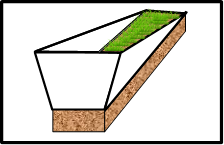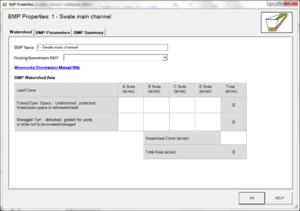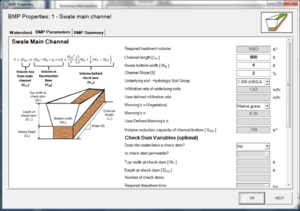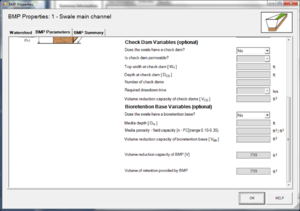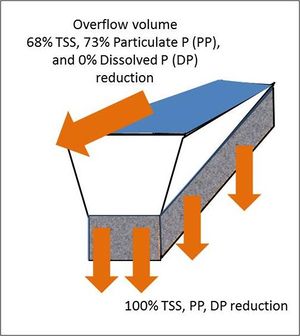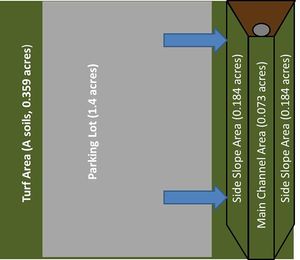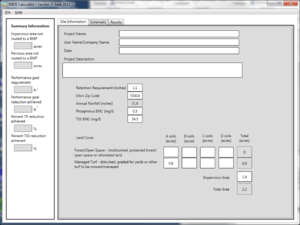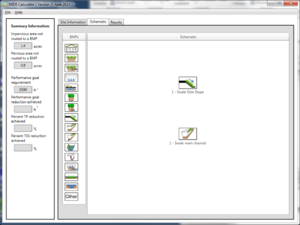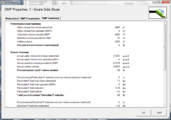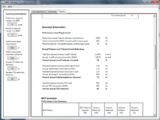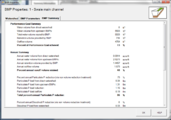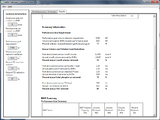
Requirements, recommendations and information for using swale without an underdrain as a BMP in the MIDS calculator Revision as of 21:49, 7 June 2021 by Mtrojan (talk | contribs) (→Model input requirements and recommendations)
For a swale main channel BMP (no underdrain), stormwater can be retained through three separate methods. Stormwater can infiltrate into the soils as it travels through the main channel to the outflow, stormwater can pond behind a check dam and infiltrate into the underlying soils, or stormwater can be stored in the pore spaces of an engineered bioretention base and infiltrate into the underlying soils. If stormwater runoff to the main channel flows over a side slope through sheet flow, then a swale side slope BMP should be used in combination with the swale main channel BMP in the MIDS calculator. All pollutants in the infiltrated water are credited as being reduced. A portion of pollutants in the stormwater that flows through the channel outflow is removed through filtration and sediment removal.
Contents
- 1 Changes to Version 4 of the MIDS Calculator
- 2 MIDS calculator user inputs for swale main channel
- 3 Routing stormwater runoff to swales and swale side slopes in the MIDS Calculator
- 4 Model input requirements and recommendations
- 5 Methodology
- 6 Routing
- 7 Assumptions for Swale Main Channel
- 8 Swale Side Slope and Main Channel example (version 2)
- 9 Requirements
- 10 Recommendations
- 11 Information
- 12 Links to MIDS pages
Changes to Version 4 of the MIDS Calculator
The particulate phosphorus credit has been reduced from 73 to 68 percent to match the TSS reduction. Particulate pollutant removal cannot exceed sediment removal.
MIDS calculator user inputs for swale main channel
For swale main channel systems, the user must input the following parameters to calculate the volume and pollutant load reductions associated with the BMP.
- Watershed tab
- BMP Name: this cell is auto-filled but can be changed by the user.
- Routing/downstream BMP: if this BMP is part of a treatment train and water is being routed from this BMP to another BMP, the user selects the name of the BMP to which water is being routed from the dropdown box. All water must be routed to a single downstream BMP. Note that the BMP receiving the routed water must be included by the user in the Schematic tab or the BMP will not appear in the dropdown box.
- BMP Watershed Area: BMP watershed areas are the areas draining directly to the BMP. Values can be added for four soil types (Hydrologic Soil Groups (HSG) A, B, C, D) and for three Land Cover types (Forest/Open Space, Managed Turf and impervious). The surface area of the BMP should be included as a managed turf land cover under the hydrologic soils group of the native soils located under the BMP. Units are in acres.
- If a swale side slope is routed to this BMP, do not include the side slope watershed areas for the swale main channel since this would effectively double-count the side slope contributing area.
- BMP Parameters tab
- Channel length (LC): This is the length of the swale channel from the furthest upstream point to the furthest downstream point. Units are in feet.
- Swale bottom width (WB): This is the average bottom width of the swale main channel. Units are in feet. Based on design restrictions, the bottom width cannot be less than 2 feet.
- Channel slope (S): This is the slope of the channel. Units are in percent. The slope is calculated by taking the difference between vertical elevations at the upstream and downstream points of the swale and dividing by the horizontal distance between the two locations. The slope therefore represents an average slope over the length of the swale. If the slope varies over the length of a swale, the user should enter the average slope over the entire length rather than break the swale into separate smaller lengths. Based on design restrictions, the channel slope cannot be less than 0.5 percent or greater than 4 percent.
- Underlying soil - Hydrologic Soil Group: The user selects the most restrictive soil (lowest hydraulic conductivity) within 5 feet of the soil surface or the soil/media interface (if a bioretention base is utilized) of the swale main channel. There are 14 soil options that fall into 4 different Hydrologic Soil Groups (Hydrologic Soil Group (HSG) A, B, C, or D) for the user. Once a soil type is selected, the corresponding infiltration rate will populate the “Infiltration rate of underlying soils” field. The user may also select “User Defined.” This selection will activate the “User Defined Infiltration Rate” cell, allowing the user to enter a different value from the value in the predefined selection list. The maximum allowable infiltration rate is 1.63 inches per hour.
- Manning’s n (Vegetation): The user selects a type of vegetation cover on the swale main channel, which populates a corresponding Manning’s n. The vegetation types are mowed turf or native grasses. Mowed turf would be selected if the main channel is mowed on a consistent basis. Native grasses would be selected if the main channel is left to grow or is mowed infrequently. Once a vegetation cover is selected, the corresponding Manning’s n will populate in the “Manning’s n” field. The user may also select “User Defined.” This selection will activate the “User Defined Manning’s n” cell, allowing the user to enter a value different from the values in the predefined selection list.
- Does the swale have a check dam?: This is a YES/NO question. The user selects YES if one or more check dams have been installed in the swale main channel. By selecting YES, the “Is check dam permeable?” input box will become active.
- Is check dam permeable?: This is a YES/NO questions. The user selects YES if the check dams are permeable, allowing stormwater to filter through the media and NO if they are impermeable, acting as a dam and providing extended detention in the swale main channel. If NO is selected, the design parameters associated with the check dam will become active. If YES is selected, the design parameters will remain inactive as no credit toward the performance goal is obtained for permeable check dams.
- Top width at check dam (WT): This is the width of the check dam at the overflow elevation (top of check dam) and is used to calculate the storage volume behind the check dam. Units are in feet.
- Depth at check dam (DCD): This parameter represents the elevation change between the overflow point of the check dam (top of check dam) and the soil surface of the swale. Units are in feet.
- Number of check dams: This parameter is the number of check dams built throughout the length of the swale main channel. If multiple check dams are constructed, enter the average value of all dams for top width and depth.
- Required drawdown time: This is the time in which the stormwater captured and ponded behind the check dam must drain into the underlying soil/media. The user may select from predefined values of 48 or 24 hours. The MPCA Construction Stormwater General Permit requires drawdown within 48 hours, but 24 hours is Highly Recommended when discharges are to a trout stream. The calculator uses the underlying soil infiltration rate and the “Depth at check dam” to check if the BMP is meeting the drawdown time requirement. The user will encounter an error and be required to enter a new “Depth at check dam” if the stormwater stored in the BMP cannot drawdown in the required time.
- Does the swale have a bioretention base?: This is a YES/NO question. Answer YES if the swale main channel has engineered soils similar to a bioretention basin. Answer NO if the swale main channel has native soils rather than engineered media. If YES is selected, then the design parameters associated with the bioretention base will be activated.
- Media depth (DM): This is the depth of the bioretention base media installed from the surface of the swale main channel down to the native soils. Units are in feet.
- Media porosity minus field capacity (n - FC): This is the ratio of media pore space to the total media volume in the bioretention base media installed from the surface of the swale main channel down to the native soils. If multiple types of media are used in the BMP, this value should be a weighted average of the soil water storage values of the media installed from the surface of the swale main channel down to the native soils. Values for porosity and field capacity based on soil type can be found here. The user inputs this value in cubic feet of pore space per cubic feet of media. The recommended range for this value is 0.15 to 0.35.
- BMP Summary Tab: The BMP Summary tab summarizes the volume and pollutant reductions provided by the specific BMP. It details the performance goal volume reductions and annual average volume, dissolved P, particulate P, and TSS load reductions. Included in the summary are the total volume and pollutant loads received by the BMP from its direct watershed, from upstream BMPs, and a combined value of the two. Also included in the summary are the volume and pollutant load reductions provided by the BMP, along with the volume and pollutant loads that exit the BMP through the outflow. This outflow load and volume is what is routed to the downstream BMP, if one is defined in the Watershed tab. Finally, percent reductions are provided for the percent of the performance goal achieved, percent annual runoff volume retained, total percent annual particulate phosphorus reduction, total percent annual dissolved phosphorus reduction, total percent annual TP reduction, and total percent annual TSS reduction.
Routing stormwater runoff to swales and swale side slopes in the MIDS Calculator
The Minimal Impact Design Standards (MIDS) Calculator separates side slopes and the main channel of swales into separate practices. This creates the potential for inaccurately routing water, since in reality side slopes and main channels are part of a single swale system. This page provides guidance for routing water to swales in the MIDS Calculator.
Swale configuration in the MIDS Calculator
The MIDS Calculator separates swale side slopes and swale main channels into separate best management practices. This is because infiltration and pollutant retention calculations differ for the side slope and the main channel. Descriptions of modeling assumptions and calculations are found at the following links.
The primary difference between side slopes and main channels is due to increased potential for infiltration in a main channel resulting from different configurations. Specifically, infiltration in a main channel is affected by length of the swale, presence or absence of impermeable check dams, and presence or absence of engineered media. These configurations are either not available for side slopes or have limited impact on infiltration.
Potential swale configurations
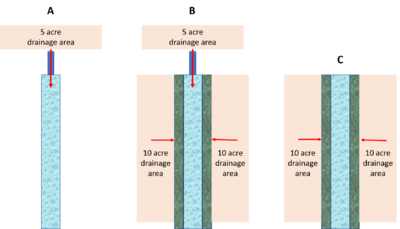
In reality, swale side slopes and main channels are part of a single swale practice. There are three possible configurations of swales. Configuring and routing water to them correctly is essential to correctly modeling swales.
- Swale main channels with direct discharge to it and no side slopes. This situation is rare, but there may be situations where water is discharged, such as from a pipe, directly into a swale and the swale has no side slopes.
- Swale main channels with direct discharge to it and one or more side slopes.
- Swale main channels with one or more side slopes and no direct discharges to the swale.
These configurations are shown in the adjacent image.
Configuring and routing water to a swale practice
- Swale main channels with direct discharge to it and no side slopes. In this situation, only the swale main channel is used in the MIDS Calculator.
- If the discharge water to the swale main channel is coming directly from another treatment practice, such as a bifiltration practice (e.g. bioretention with an underdrain), do not enter any contributing pervious or impervious acreage to the swale main channel. Make sure the upstream practice is being routed to the swale main channel.
- If the discharge water to the swale main channel is not from another treatment practice, enter the impervious and pervious acres contributing to this discharge into the Watershed tab for the swale BMP properties.
- If the discharge water to the swale main channel contains both treated and untreated water, enter only acreages contributing to the untreated discharge. Make sure the upstream BMP for the treated water is routed to the swale main channel.
- Swale main channels with direct discharge to it and one or more side slopes. For this situation, apply the above methodology to the direct discharge to the main channel. For the side slope, enter pervious and impervious acres to the Watershed tab for the swale side slope and route the side slope to the main channel. DO NOT ROUTE THESE ACREAGES TO THE MAIN CHANNEL. If there is more than one side slope, use multiple side slopes routed to the one main channel.
- Swale main channels with one or more side slopes and no direct discharges to the swale. If all the discharge to the main channel is from swale side slopes, enter pervious and impervious acres to the Watershed tab for the swale side slope and route the side slope to the main channel. DO NOT ROUTE THESE ACREAGES TO THE MAIN CHANNEL. If there is more than one side slope, use multiple side slopes routed to the one main channel.
Model input requirements and recommendations
If the following requirements for inputs into the MIDS calculator are not met, then an error message will inform the user to change the input to meet the requirement.
- Swale bottom width cannot be less than 2 feet
- Channel slope cannot be greater than 4 percent or less than 0.5 percent
- Manning’s n cannot be greater than 1
- Infiltration rates of the underlying soils cannot exceed 1.63 inches per hour
- The stormwater behind the check dam must meet the user-specified drawdown time requirement. The drawdown time requirement is checked by comparing the specified drawdown time with the calculated drawdown time (DDTcalc) calculated using the following
\(DDT_{calc} = D_{CD}/(I_R/ 12)\)
Where
- DCD is the depth of the check dams (ft); and
- IR is the infiltration rate of the native soils (inches/hr).
If the DDTcalc is greater than the user-specified required drawdown time then the user will be prompted to enter a new check dam depth or infiltration rate of the native soils.
Methodology
Required treatment volume
Required treatment volume, or the volume of stormwater runoff delivered to the BMP, equals the performance goal (1.1 inches or user-specified performance goal) times the impervious area draining to the BMP plus any water routed to the BMP from an upstream BMP. This stormwater is delivered to the BMP instantaneously.
Volume reduction
The swale main channel BMP without an underdrain can achieve volume reduction capacity through three mechanisms. The first is from infiltration as the stormwater travels along the main channel (VMC). The second is from infiltration of stormwater that is stored behind an impermeable check dam (if installed) (VCD). The third is from infiltration of stormwater that is stored in the media of the bioretention base (if installed) (VBB).
The total instantaneous Volume reduction capacity of BMP [V] due to these three mechanisms is calculated using BMP design inputs provided by the user. This Volume reduction capacity of BMP [V] is then compared to the Required treatment volume in order to determine the Volume of retention provided by BMP, which is the instantaneous volume credit that can be claimed for that BMP.
Volume reduction capacity due to infiltration along the swale main channel (VMC)
With no real storage capacity unless impermeable check dams are present, the main method of stormwater volume reduction in a swale with no underdrain is via infiltration as the stormwater travels through the main channel. The infiltration capacity of the swale main channel bottom (VMC) is estimated based on analysis of long-term modeling results as described in the following paragraphs.
To determine the average annual volume reduction credit given for a swale main channel, the P8 water quality model was used. Fifty-five (55) years of hourly rainfall data were modeled for swale main channels with various configurations of channel length, swale bottom width, channel slope, soil infiltration rate, and Manning’s n parameters. The model results provided annual average volume reduction rates. Multivariate regression was used to assess model results to determine the relationships between swale modeling parameters and annual volume reductions. The observed relationships are paired with the user-provided inputs to calculate an annual percent stormwater volume reduction for the swale main channel in the calculator.
To obtain the volume reduction capacity of the channel bottom (VMC), the annual volume reductions are converted to a volume reduction capacity. This is accomplished through the use of performance curves developed from a range of modeling scenarios. The performance curves use the annual volume reduction percentage, the infiltration rate of the underlying soils, the contributing watershed percent impervious area, and the size of the contributing watershed to calculate the volume reduction capacity achieved through infiltration along the swale main channel (VMC).
Volume reduction capacity of check dams (VCD)
In addition to the volume reduction provided as stormwater travels through the main channel, the storage capacity of the swale main channel can be increased through the addition of check dams. If the check dams are impermeable, they provide areas of ponded water in the swale main channel that will infiltrate into the soils. The Volume reduction capacity of BMP [V] gained through the addition of check dams in the system is equal to the storage volume provided behind a check dam multiplied by the number of check dams installed. The storage volume behind a check dam (VCD) is given by
\(V_{CD}= D_{CD}^2/S * (1/2 W_B + 1/6 (W_T -W_B )) \)
Where
- DCD is the depth of the check dam (ft);
- S is the slope of the swale main channel in percent;
- WB is the bottom width of the swale in feet; and
- WT is the top width of the check dam in feet.
The volume reduction capacity of the check dams (VCD) is added to the volume reduction capacity achieved through infiltration along the swale main channel (VMC).
Volume capacity of a bioretention base (VBB)
The third method of volume reduction provided in a swale main channel BMP is through the addition of a bioretention base. This is a layer of engineered soils above the native soils capable of storing water and allowing it to infiltrate into the underlying native soils. The Volume reduction capacity associated with this BMP component is equal to the amount of water that can be instantaneously captured by the BMP in the media. The captured volume (VBB) is given by
\(V_{BB} = D_M * W_B * L_C * (n - FC)\)
Where
- DM is the media depth of the bioretention base (ft);
- WB is the main channel width (ft);
- LC is the main channel length (ft); and
- (n-FC) is the media porosity minus the field capacity.
If a bioretention base is selected, then the credit given for the infiltration into the soils of the main channel (VMC) is removed since all stormwater that would have infiltrated into the soils as it travels through the main channel is now instead collected in the pore space of the media. If check dams are installed the total stormwater volume reduction capacity of the swale main channel would be equal to the volume reduction provided by the bioretention base (VBB) plus the storage capacity of the check dams (VCD).
Comparison of volume reduction capacity with volume performance goal
The MIDS calculator compares the Volume reduction capacity of BMP [V] with the Required treatment volume, and the lesser of the two values is used to populate the Volume of retention provided by BMP. This comparison between potential and actual treatment volumes ensures that the BMP does not claim more credit than is due based on the actual amount of water routed to it. The Volume of retention provided by BMP is the actual volume credit the BMP receives toward the instantaneous performance goal. For example, if the BMP is oversized the user will only receive volume credit for the Required treatment volume routed to the BMP.
Annual volume retention is assessed by converting the instantaneous Volume reduction capacity of BMP [V] to an annual volume reduction percentage. This is accomplished through the use of performance curves developed from a range of modeling scenarios. These performance curves use the Volume reduction capacity of BMP [V], the infiltration rate of the underlying soils, the percent imperviousness of the contributing watershed area, and the size of the contributing watershed to calculate the Percent annual runoff volume retained and annual Retention volume provided by BMP.
Pollutant reduction
Pollutant removal can be accomplished both via volume reducing and non-volume reducing processes in this BMP. Pollutant load reductions are calculated on an annual basis and are thus dependent upon the volume of water retained by the BMP through infiltration and the volume of water treated by filtration and sediment removal in the BMP.
Pollutant reduction via volume reduction
The previously discussed annual volume reduction percentages are used to determine the annual pollutant load reductions achieved by the BMP. All pollutants in the infiltrated water are considered captured for a 100 percent removal. While oversizing a BMP above the Required treatment volume will not provide additional credit towards the performance goal volume, it may provide additional pollutant reduction.
Pollutant reduction via non-volume reduction
For water routed to the main channel that does not infiltrate, pollutant removal occurs through filtration and sediment removal. Removal rates for this water are 68 percent for total suspended solids (TSS), 68 percent for particulate phosphorus, and 0 percent for dissolved phosphorus.
NOTE: The user can modify event mean concentrations (EMCs) on the Site Information tab in the calculator. Default concentrations are 54.5 milligrams per liter for total suspended solids (TSS) and 0.3 milligrams per liter for total phosphorus (particulate plus dissolved). The calculator will notify the user if the default is changed. Changing the default EMC will result in changes to the total pounds of pollutant reduced.
Routing
Overflow from a swale main channel can be routed to any other BMP, except for a green roof, a swale side slope, or any BMP in a stormwater treatment sequence that would cause stormwater to be rerouted back to the swale main channel already in that sequence. All BMPs can be routed to the swale main channel.
Assumptions for Swale Main Channel
The following general assumption applies in calculating the credit for a swale main channel. If this assumption is not followed, the stormwater volume and pollutant reduction credits cannot be applied.
- The swale main channel has been properly designed, constructed, and will be properly maintained according to specifications for filtration systems.
Swale Side Slope and Main Channel example (version 2)
The runoff from a 1.4 acre parking lot surrounded by 0.359 acres of pervious turf area flows through sheet flow over one of the side slopes of a swale and into a swale main channel. The soils across the area have a unified soils classification classification of SW (HSG type A soil). A second side slope associated with the main channel does not receive runoff from impervious surfaces. Each of the swale side slopes are 800 feet long by 10 feet wide with a side slope of 5H:1V. The main channel of the swale is 800 feet long by 4 feet wide with a 2 percent slope. The swale main channel does not have an underdrain, bioretention base or check dams. The maintenance on the swale calls for mowing once a year. The following steps detail how this system would be set up in the MIDS calculator.
Step 1: Determine the watershed characteristics of your entire site. For this example we have a 2.2 acre site with 1.4 acres of impervious area (parking lot) and 0.8 acres of pervious area in type A soils. The pervious area includes the turf area and the area of the swale side slopes and main channel.
Step 2: Fill in the site specific information into the Site Information tab. This includes entering a ZIP Code (55414 for this example) and the watershed information from Step 1. The Managed Turf area includes the turf area, the area of the side slopes and the area of the main channel. ZIP code and impervious area must be filled in or an error message will be generated. Other fields on this screen are optional.
Step 3: Go to the Schematic tab and drag and drop a Swale Side Slope and a Swale Main Channel icon into the Schematic Window.
Step 4: Determine the watershed characteristics for each of the BMP components. For this example the swale side slope watershed includes 1.4 acres of impervious area and 0.543 acre of pervious area (0.359 acre of turf area plus 0.184 acre of swale side slope). The watershed of the swale main channel includes the pervious area of the main channel (0.073 acre) and the pervious area of the other swale side slope (0.184 acre) for a total pervious area of 0.257 acre. Since no impervious area is being routed to the second swale side slope, the area can be included in the direct watershed area of the main channel. However, the second swale side slope could be placed in the calculator as an additional BMP. Including it as a separate BMP provides a slightly greater annual volume reduction and more closely represents the true system.
Step 5: Open the BMP properties for the swale side slope by right clicking on the Swale Side Slope icon and selecting Edit BMP Properties, or by double clicking on the Swale Side Slope icon.
Step 6: If help is needed, click on the Minnesota Stormwater Manual Wiki link or the Help button to review input parameter specifications and calculations specific to the Swale Side Slope BMP.
Step 7: Fill in the specific BMP watershed information (1.4 acres of impervious and 0.543 acre of Managed Turf on A Soils). Route the side slope BMP to the main channel BMP.
Step 8: Enter in the BMP design parameters into the BMP parameters tab. This Swale Side Slope example would require the following entries:
- Side slope [H:V]: 5:1
- Flow path length: 10 feet
- Channel length: 800 feet
- Underlying soil – Hydrologic Soil Group: 4 SW (HSG A, 1.63 in/hr) (selected in dropdown box)
- Manning’s n (vegetation): Native grass (selected in dropdown box)
- MIDS calculator screen shots for inputs for swale side slope and wet swale. Click on an image for enlarged view.
- MIDS calculator screen shots of results and summary tabs. Click on an image for enlarged view.
Step 9: Click on BMP Summary tab to view results for this BMP.
Step 10: Click on the OK button to exit the BMP properties screen. An arrow will appear showing that the swale side slope has been routed to the swale main channel.
Step 11: Open the BMP properties window for the swale main channel by right clicking on the Swale main channel icon and selecting Edit BMP properties, or by double clicking on the “Swale main channel” icon.
Step 12: If help is needed, click on the Minnesota Stormwater Manual Wiki link or the Help button to review input parameter specifications and calculation specific to the Swale main channel BMP.
Step 13: Enter in the watershed information for the swale main channel in the Watershed tab (0.257 acre for Pervious Turf on A Soil, which includes the area of the main channel and the other side slope).
Step 14: Enter the BMP design parameters into the BMP Parameters tab. This Swale main channel example would require the following entries:
- Channel length: 800 feet
- Swale bottom width: is 4 feet
- Channel slope: 2 percent (%)
- Underlying soil – Hydrologic Soil Group: 4 SW (HSG A, 1.63 in/hr) (selected in dropdown box)
- Manning’s n (vegetation): Native grass (selected in dropdown box)
- Does the swale have a check dam: No
- Does the swale have a bioretention base: No
Step 15: Click on BMP Summary tab to view results for this BMP.
Step 16: Click on the OK button to exit the BMP Properties screen.
Step 17: Click on Results tab to see overall results for the site.
Requirements

- At least 3 feet of separation from the bottom of an infiltration system to the seasonal high water table (for swales with a bioretention base)
- If soils below the bottom of the infiltration system are ripped to promote infiltration, at least 2 feet of separation from the bottom of the ripped zone to the seasonal high water table (for swales with a bioretention base)
- Use the most restrictive infiltration rate within 5 feet of the bottom of the BMP
- For measured infiltration rates, apply a safety factor of 2
- Pretreatment for infiltration systems (for swales with a bioretention base)
Recommendations
- Drawdown time of 24 hours when the discharge is to trout streams
- Field tested infiltration rates rather than table values
Information
- Guidance on determining infiltration rates
- Information on site constraints (shallow soil, karst, etc.)
- Guidance on pretreatment
- Information on soil mixes
- Construction specifications for filtration BMPs
- Information on operation and maintenance of filtration BMPs.
Links to MIDS pages
- Overview of Minimal Impact Design Standards (MIDS)
- Performance goals for new development, re-development and linear projects
- Design Sequence Flowchart-Flexible treatment options
- Community Assistance Package
- MIDS calculator
- Performance curves for MIDS calculator
- Training and workshop materials and modules
- Technical documents
